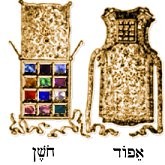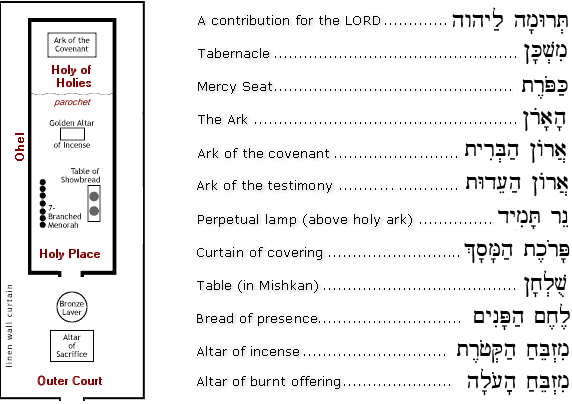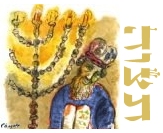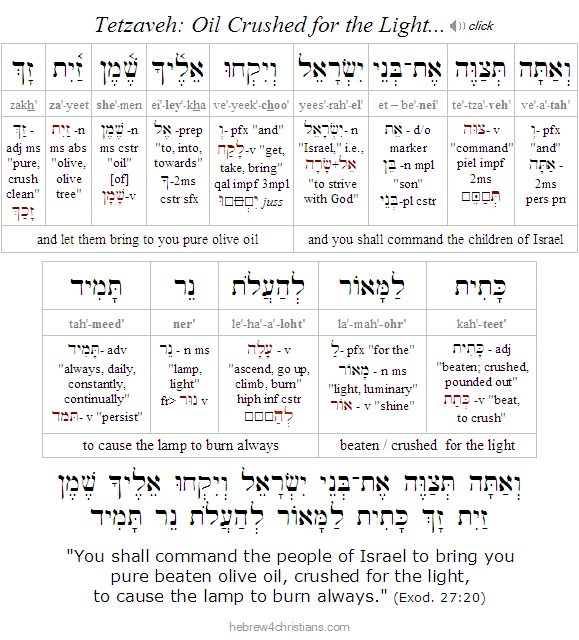|
|
 |
 |
 |
|
Weekly Torah Reading
|
|
|
Parashat Tetzaveh ("you shall command")
|
|
|
Click on the links to display the Scriptures:
|
|
|
|
 |
 |
 |
|
Torah Reading Overview
|
|
|
Tetzaveh is the 2nd person imperfect of tzavah, meaning "to command" (mitzvah), and this reading begins with God telling Moses to command the children of Israel to provide pure olive oil to feed the "everlasting flame" of the menorah. The priestly garments, worn by the Kohanim (priests) while serving in the Sanctuary, are also described in this Torah portion.
|
|
|
|
 |
 |
|
"You shall command the people of Israel that they bring to you pure beaten olive oil
for the light, that a lamp may regularly be set up to burn." (Exodus 27:20)
|
 |
 |
|
According to Jewish tradition, only the first few drops of shemen (oil) pressed from an olive (zayit) were to be used for the menorah, since these were considered the "first fruits" of the olives and also the brightest of oils.
The menorah was lit every afternoon and would burn throughout the night. Every morning the kohen (priest) would enter the kodesh section of the mishkan to empty the ashes from the lamps and insert new wicks. However, a midrash says that the westernmost light -- ner ma'aravi -- would remain burning, which was then used to light the other six lamps (similar to the way the shamash candle is used to light the other candles at Chanukah). Only after the other lamps were lit would he blow out the ner ma'arivi, clear its ashes, and rekindle it.
|
 |
 |
|
Only descendants of Aaron were allowed to wear the priestly garments (a Levite or regular Israelite could not do so), and only while performing avodah (service) in the mishkan. A regular priest (kohen hedyot) had four required garments, whereas the High priest (kohen gadol) had eight.
All kohanim (regular priests) wore: 1) the ketonet (כּתנת) -- a full length tunic or long shirt; 2) michnasayim -- short pants; 3) migba'at -- a band of white linen wound into a pointed turban; and 4) avnet -- a (very!) long sash that was wound above the waist. The avnet was over 40 feet in length!
In addition to these, the Kohen Gadol wore: 5) the efod (אפוד), an apron-like garment (tied in the front) made of blue, purple and red-dyed wool, linen and gold thread; 6) the choshen (חשׁן), a breastplate with a pouch that contained twelve precious stones inscribed with the names of the twelve tribes of Israel; 7) a me'il (מעיל) -- a robe of blue wool, with golden bells and decorative pomegranates on its hem; 8) the tzitz zahav (צּיץ זהב) -- a golden headband bearing the inscription Kodesh la-Adonai - "Holy to the LORD."
Notice that neither the regular kohanim nor the Kohen Gadol wore shoes or slippers! In other words, they served in the mishkan (and later at the Temple) barefoot.
According to Jewish tradition, the bells were worn on the High Priest's coat in order to "scare off" any holy angels that were serving in the Kodesh section of the mishkan (apparently God did not want any of the angels there to be critical of the High Priest as he performed his duties). Another tradition states that the bells were used so that the Israelites would remember to pray for the priest as he served on their behalf.
The choshen or breastplate of the High Priest is described in this portion of Torah. This sacred vestment was worn over the ephod (linen apron) and contained two special gemstones called the urim v'tummin (אורים ותומים) or "lights and perfections" (Exod. 28:30; Lev. 8:8; Num. 27:21; Deut. 33:8). These stones were used to discern the will of God in some cases (1 Sam. 14:41; 28:6; Ezra 2:63; Neh. 7:65). Some have claimed that the Shekhinah would cause the urim and tummim to light up and shine upon the avnei choshen (the 12 gemstones in the choshen that represented the 12 tribes of Israel). Since each stone was inscribed with a name of a tribe of Israel, the letters illuminated on the choshen would reveal an answer to a question posed by the High Priest.
|
 |
 |
|
The choshen was arranged with four rows of three stones. Each stone was inscribed with six letters representing a name of a tribe of Israel (for a total of 72 letters).
- Row 1: Reuben (ruby), Simeon (topaz), and Levi (garfinkel)
- Row 2: Judah (carbuncle), Issachar (sapphire), and Zebulun (pearl)
- Row 3: Dan (jacinth), Naphtali (agate) and Gad (crystal);
- Row 4: Asher (emerald), Joseph (onyx), and Benjamin (yashneh- an unknown stone).
According to the Gemara (Sotah), the "shamir" was a miraculous worm, as small as a grain of barley, that was used to engrave the names of the tribes on the stones.
Believers in the Mashiach Yeshua are likewise appointed to be a kingdom of priests (1 Pet 2:9) and have direct access to the Ruach HaKodesh (Holy Spirit) to discern the will of God. We do this through faith, asking the LORD for wisdom, and trusting in His Light and Perfection to guide us into all truth (John 16:3).
|
 |
 |
|
Mizbeach Haketoret - The Altar of Incense
|
 |
 |
|
The Altar of Incense (mizbeach haketoret) was the second altar of the mishkan (the first was the large Mizbeach Ha'olah, or altar for animal sacrifices in the outer court). It was constructed of wood overlaid with pure beaten gold and placed in the kodesh section of the structure (next to the menorah and shulchan, perhaps right next to the parochet (curtain) that separated the Holy Place from the Holy of Holies (kodesh hakodashim).
|
|
|
|
|
 |
 |
|
Twice a day, in the morning and again in the afternoon, a priest would burn ketoret (incense) on this altar, as an intercessory reminder to the LORD on behalf of Israel.
A midrash states that even though there was only a thin layer of gold covering the Altar of Incense, the wood was never scorched by the fire.
|
|
 |
 |
|
Why Aaron's Descendants and Not Moses'?
|
 |
 |
|
In connection with the avodah (service) at the mishkan, the question may arise as to why Aaron's descendants were chosen to serve and not Moses'. In other words, why wasn't Moses chosen to be the Kohen Gadol for Israel?
Rashi states that the LORD at first wanted Moses to be the Kohen Gadol, but because he refused to lead Israel at the incident of the burning bush, God chose his brother (and his descendants) to be kohanim, whereas Moses (and his descendants) would be Levites (assistants) instead.
Prophetically, even though Moses himself was a type (or picture) of the Mashiach Yeshua, he was unable to enter into the land of ultimate promise, and the entire priesthood system based on the mishkan (and later, the Temple) was destined to be superceded by the greater priesthood after the order of Malki-Tzedek (Hebrews 7).
|
 |
 |
|
The Haftarah of Parashat Tetzaveh gives the details of the construction of the altar in the mysterious heavenly Temple of the Mashiach and the dedication of that temple in the Messianic Age. There is some debate among Orthodox Jews if this temple is built by God Himself (and descends to earth) or if it is built by the Messiah during the Messianic era.
|
 |
 |
 |
|
Brit Chadashah Overview
|
|
|
|
The Brit Chadashah reading concerns the spiritual Temple and our relationship to that Temple through Yeshua as our Kohen Gadol after the order of Malki-Tzedek. A key phrase here is, "We have an altar from which those who serve the tent have no right to eat" (Heb. 13:10), which indicates that the altar of Messiah is not available to those who attempt to find merit (זְכוּת) through the Levitical system (i.e., the ritualistic expression of the Sinai Covenant given in the law of Moses).
The mention of Yeshua suffering "outside the camp" refers to the sin offerings (chatat and asham) that were required for atonement (כַּפָּרָה) to be made. These sacrifices had to be offered by the anointed High Priest who would sprinkle the blood of the sacrifice seven times inside the Tabernacle on the golden altar opposite the curtain before the Holy of Holies (פָּרכֶת). The chelev (חֵלֶב), or fat, was burned on the altar, but unlike other offerings, the rest of the animal (its hide, flesh, and its body parts) would be taken "outside the camp" to be burned with fire. Followers of Yeshua are likewise told to go "outside the camp" to bear the reproaches of those who still hold to the terms of the older covenant (Heb. 13:12).
Blessing after Torah Study:
|
 |
|
|
 |
 |
 |
|
Click the following links to hear the desired chapters read from this week's Torah:
|
|










